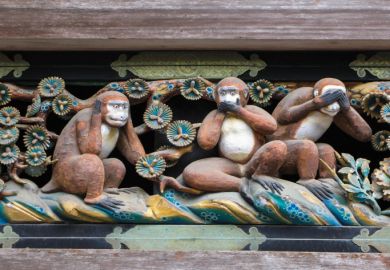The title of this volume is misleading, implying that the orientalist-Anglicist argument ended in the 1840s when the East India Company's directors supported the modernists who demanded education in English to spread western knowledge. Far from it. Nothing is resolved so neatly in India, and the controversy continues to this day - holding the future of India's young, indeed, the country itself, hostage to political manipulation, bureaucratic empire-building and a criminally lopsided sense of priorities that starves schools and colleges of funds while lavishing money on space, missile and nuclear programmes.
Murli Manohar Joshi, who holds what is fashionably called the human resources development (read education) portfolio in the Bharatiya Janata Party government and is engaged in formulating a national education policy, adds a new twist to existing dichotomies. He is a physicist who is also active in Hindu revivalist organisations, and is blamed for encouraging the rewriting of history textbooks and the introduction of religious rituals in state schools. But Joshi recently surprised many Indians by promising to allow foreign investment in education, which no previous government had dared to do. Indira Gandhi did agree in a fit of absent-mindedness to Lyndon Johnson's proposal that the millions of dollars that India owed the United States in loan repayment, which could not be repatriated because of exchange control, should be ploughed into education instead. The plan ("to take charge of and thereafter pay for their culture. Not their army. Nor their irrigation systems. Their very culture," as Daniel Patrick Moynihan, the US senator, exclaimed) was dropped when her advisers pointed out that it would be political dynamite.
Money is part of the bigger problem of syllabus and curriculum. India's constitution makes education a state responsibility, but with the heterogeneous ideologies of ruling parties, and the central government's reserve powers with ultimate control of the purse strings, there is little agreement on what should be taught and how.
These two questions exercised British administrators over a span of roughly 60 years, from Warren Hastings, who made orientalism the official policy, to Lord Macaulay, who aimed to create "a class of persons, Indian in colour and blood but English in tastes, in opinions, in morals and in intellect". Lynn Zastoupil of Rhodes College, Memphis, Tennessee, and Martin Moir, who was with the British Library's Oriental and India Office collections, have put together their letters, notes, reports and petitions in a fascinating anthology with an exhaustive 66-page introduction. The documents speak for themselves, revealing much about imperial thinking. Students, academics, diplomats, policy-makers and anyone with an interest in today's India may find the light they throw on current problems even more useful, though this may not have been the editors' intention.
The message of their introduction - that Indians themselves were not merely passive observers of the great debate and that the impact of Macaulay's famous minute was not all that decisive - is less convincing. Zastoupil and Moir buttress the first point, which C. A. Bayly made in Indian Society , by including five documents by Indians. But with no disrespect to Bayly's notion of an Indian ecumene, the urgings and pressures to which the authors might have responded - like the Muslim deputation that waited on Lord Minto in 1906 after the viceroy mooted the idea of a loyal Muslim League - can only be guessed. Much is made of Raja Rammohun Roy's 1823 plea for instruction in the sciences instead of arcane metaphysics, but he was following in the footsteps of Charles Grant, a born-again Christian who made the same demand 31 years earlier, though for mainly evangelical reasons. In contrast, nothing came of Radhakant Deb's far-sighted suggestion of agricultural and industrial schools. On the whole, Indian views were acceptable when they coincided with those of the rulers.
The editors are right in saying that the directive with which the company tried to wrap up the debate in 1841 was not definitive. It upheld an earlier resolution that it was "the great object of the British government to promote European science, and literature" but kept alive orientalist hopes by refusing to comment on "the most efficient mode of communicating and disseminating European knowledge". In practice, this compromise left the field clear for the pursuit, with varying degrees of success and with some ludicrous results, of an anglophile Holy Grail. Macaulay's contribution was part of a process that set a pattern of success that created, as Sunil Khilnani put it, the great divide between Indians "who knew their Dicey from their Dickens, and those who did not". This is not the place to discuss the role of an alienated elite, but there is little doubt that the failure of post-independence leaders to break free from the controversies reflected in these documents is largely responsible for the confusion that also infects the private English-medium Christian-run schools originally set up for the Anglo-Indian community, but which are most popular with urban middle-class followers of the Macaulay ideal. Mahatma Gandhi's warning against being "carried away by a flood of western thought" and being unable to recognise that "a knowledge of letters" makes the peasant discontented with his lot and Jawaharlal Nehru's three-language formula, which left millions of Indians uneducated in all three, can both be traced to these documents. The questions raised are still pertinent. Is education an instrument of governance or the path to enlightenment? Is it for the elite or the masses? Do Indians seek a smattering of English only to get a job, as H. H. Wilson, the Oxford Sanskritist, feared, or can they really master the language, as Charles Trevelyan maintained? Money loomed large even then. Just as the economical Dutch invented Bahasa Indonesia because it was cheaper to rule the East Indies in Malay (vide Benedict Anderson), British educationists calculated that Indian clerks and copyists cost less.
Not surprisingly, the debate took place in the context of strategic planning to create a supportive lobby that would consolidate British rule, though with flashes of philanthropic concern. The early orientalists acknowledged Mogul sovereignty and knew that British power was precarious. Later administrators spoke with lofty confidence, and with an eye to what would best serve the Raj. One exception was Brian Hodgson, who warned in 1843 that though official policy "may result in supplying the country with an able body of native functionaries, they seem little calculated to meet the wants of the mass of the people, their design indeed being to meet those of the government only". He was convinced that only a system of mass education that imparted modern ideas in their own languages to as many people as possible could rejuvenate India. That meant good books, good teachers and new teacher training schools. His advice anticipated the connection Amartya Sen draws between education and economic growth, and remains sound 157 years later. But it appeals as little to India's rulers today as it did then. No wonder the brain drain has reached epic proportions, and one-time centres of excellence are reduced to production-line factories that turn out graduates who are barely employable.
Sunanda Datta-Ray was formerly editor, The Statesman , Calcutta, India.
The Great Indian Education Debate: Documents Relating to the Orientalist-Anglicist Controversy, 1781-1843
Editor - Lynn Zastoupil and Martin Moir
ISBN - 0 7007 1181 3
Publisher - Curzon
Price - £45.00
Pages - 357
Register to continue
Why register?
- Registration is free and only takes a moment
- Once registered, you can read 3 articles a month
- Sign up for our newsletter
Subscribe
Or subscribe for unlimited access to:
- Unlimited access to news, views, insights & reviews
- Digital editions
- Digital access to THE’s university and college rankings analysis
Already registered or a current subscriber? Login



